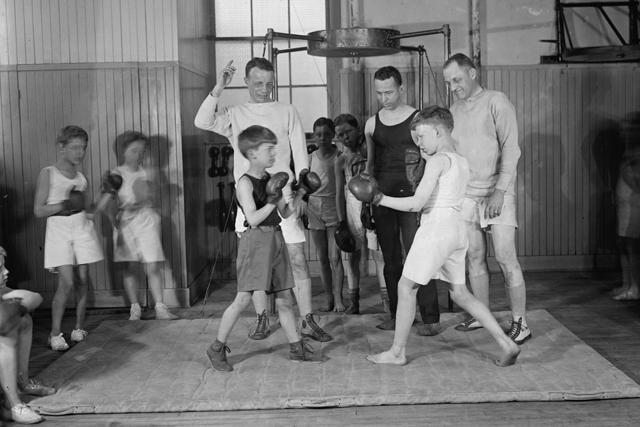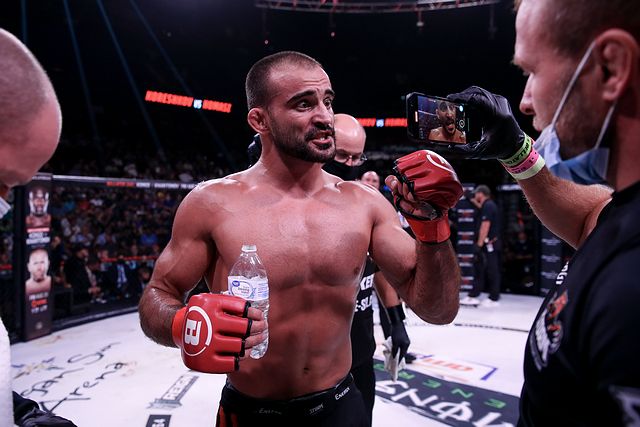Opinion: Actions vs. Consequences

Theodore Roosevelt gets boxing instruction at a gym for young
ones like himself. (Photo by Buyenlarge/Getty Images)
Editor’s note: The views and opinions expressed below are those of the author and do not necessarily reflect the views of Sherdog.com, its affiliates and sponsors or its parent company, Evolve Media.
Once upon a time, somewhere in South Florida, I went to a middle school that had both a wrestling program and a small boxing program. There was plenty of youthful aggression going on, and being that it was the 1980s, there was much less adult concern over it than there would be now. If you walked or biked to school, defending yourself was your responsibility. If you were a loner or a “weird” kid, getting picked on and winding up in physical altercations became inevitabilities. This is why the wrestling and boxing programs became important.
Recently, former Ultimate Fighting Championship competitor Mark Munoz, who was employed by Fairmont Private Schools in California, was effectively terminated for allowing two students to box each other in what he thought was a fun exercise in sport. The original story was that he allowed the students to settle a dispute, but in a later statement, he indicated he was not aware that they had issues prior to asking to box each other. A parent of one of the students became outraged upon learning what had transpired and reported the incident to school administrators.
Advertisement
Sign up for ESPN+ right here, and you can then stream UFC Fight Night 207 "Volkov vs. Rozenstruik" live on your smart TV, computer, phone, tablet or streaming device via the ESPN app.
Expecting kids of certain ages to resolve all grievances pacifistically is fairly unrealistic. Human beings are still animals with instincts. As an experienced boxing coach who has also taught other martial arts, I can tell you that honing those instincts in a controlled environment is not nearly as destructive as suppressing them. It has long been felt that not giving kids an outlet for their aggression is one of the factors that leads them to turn to something like guns, which has become an all-too-common discussion these days. The opposition to something like letting two students use their fists in a more civil setting often points to the dangers associated with fighting, which often involve tropes that gloss over the inherent dangers of other sports we allow children to play all the time. Think football and wrestling and the joint, back and neck injuries, many of them severe, that can result. Boxing has always had a stigma associated with it, despite the fact that football has many more occurrences of CTE. Kids take harsher impacts on the gridiron than they do in boxing, as a running collision between two athletes generates more force than a punch.
The fact that Munoz, 44, was a duly qualified coach and there’s always assumed risk when kids play sports should have safeguarded him from such a harsh reaction. He’s more than qualified to supervise a short skirmish, especially if he managed to keep it civil. More often than not, when the reality of a fight sets in for kids, the aggression that led to their desire to throw hands dissipates, especially if there is an attentive coach there to intervene and set rules.
The actions Munoz took weren’t morally bankrupt and surely didn’t warrant termination. I understand the situation from the school’s perspective in that parents do not expressly give their children permission to box, which means administrators are likely considering liability issues. However, there’s always an assumed risk when it comes to sports, and the situation should be weighed against the attentiveness and experience of the coach involved. Even in a worst-case scenario where Munoz allowed them to fight knowing they wanted to settle a beef with one another, I struggle to see how that’s more destructive than a climate where kids who develop aggression are secluded, ignored and begin to consider much more drastic measures in order to be seen or heard.
In closing, consider this quote from former President Theodore Roosevelt, who once held sparring matches inside the White House and also got in hot water for giving a dollar to a kid who fought a bully to defend his little sister: “When I was police commissioner, I found that the establishment of a boxing club in a tough neighborhood always tended to do away with knifing and gun-fighting among the young fellows who would otherwise have been in murderous gangs. Many of these young fellows were not naturally criminals at all, but they had to have some outlet for their activities.”
« Previous Fabricio Werdum Focused on Boxing Career: ‘I Want to Put Another Belt on the Wall’
Next Ex-UFC Heavyweight Greg Hardy to Make Professional Boxing Debut on Oct. 8 »
More




 Boxing Coverage on Sherdog.com
Boxing Coverage on Sherdog.com


